South Australian farmers are keeping a positive outlook as they seek to bounce back from the coronavirus pandemic
Possible Chinese tariff increases on Aussie barley imports hasn’t dampened the spirits of South Australian producers. Find out how each local industry is staying positive and emerging from the COVID-19 crisis.
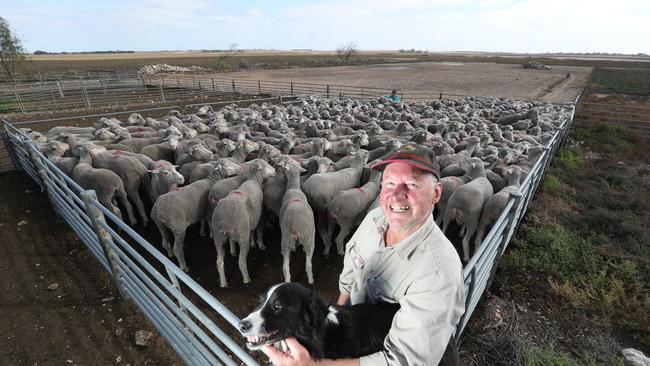
Coronavirus News
Don't miss out on the headlines from Coronavirus News. Followed categories will be added to My News.
- Bush key to breaking SA’s concentration problem
- How to get the most out of your Advertiser digital subscription
Agriculture has proven itself an economic shining light in the face of COVID-19, with the industry able to forge through the crisis due to its status as an essential service.
But news during the week that China could impose an 80 per cent tariff on imports of Australian barley, at the same time as the nation suspended beef imports from four of Australia’s major beef processing plants, is casting a shadow over the sector.
NAB agribusiness economist Phin Ziebell said while the China trade threat was a concern, there were still plenty of positives.
“Overall, agriculture is still outperforming the rest of the economy. That’s largely driven by seasonal conditions and lots of staples still being in high demand,” he said.
“But that’s not to say everyone is doing well.
“There are still challenges, especially around products that require air travel, such as pork going to Singapore.
“I feel pretty positive and would rather be in agriculture than almost anything else, but there are still some challenges.
“Nobody is getting away completely free from this (COVID-19) situation.”
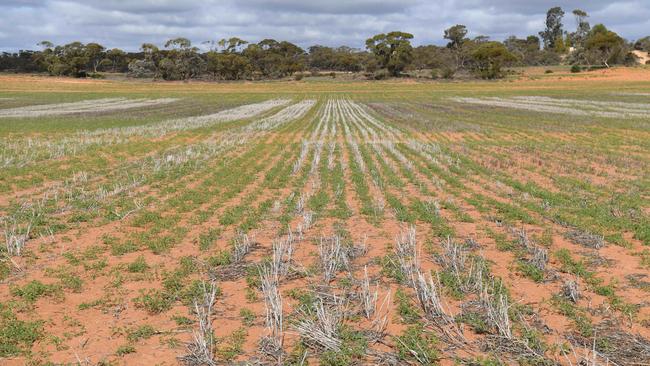
Mr Ziebell said some agricultural sectors would fare better than others through the crisis.
One of the industries hardest hit is the wool sector.
Only two years ago, Australian wool was trading at a record $20-plus a kilogram.
This week it was at $11.79kg.
“I can’t see (wool prices) getting off the ground anytime soon,” Mr Ziebell said.
“There’s been a lot of jobs lost.
“It’s not like people need to buy new clothes to go out in.”
While the wool market has been tough, sheepmeat prices are holding up well.
MORE NEWS
Love silo art? Get going to Owen
Records may fall as SA cops a soaking
Cats out of the bag in dingo crackdown
Rabobank senior animal proteins analyst Angus Gidley-Baird said sheepmeat prices were set to remain strong throughout the year.
He said reduced domestic sheep numbers would counter any global market impact.
“We’ve got the lowest sheep inventory for over 75 years, and the reduced lamb and wool production we are seeing as a result will support prices for 2020,” Mr Gidley-Baird said.
He said the ban on Australian abattoirs by China would mostly affect the price for grain-fed beef.
From a grain perspective, James Murray, the chief operations officer for the state’s major grain handler, Viterra, said recent demand for SA grain has been strong from both a domestic and global perspective.
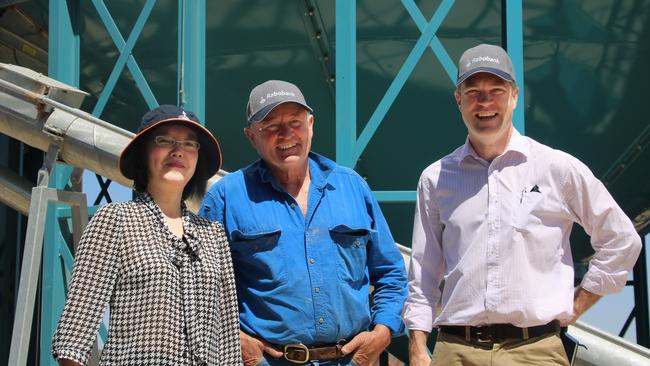
To service interstate demand, Viterra loaded two 100-wagon trains for the first time – double the size of a typical rail movement and helping bump up the total number of trains loaded to 220 since demand began in August 2018.
“Whether it’s from feedlots or flour millers, we expect demand to continue in the coming months,” Mr Murray said.
He said Viterra’s Port Lincoln terminal had also clocked up a major milestone, with one million tonnes of grain loaded onto vessels from the port since November.
“We’ve been focused on outturning grain in our system headed to a range of domestic and export destinations through the many buyers in our system,” Mr Murray said.
“We’re also looking ahead and preparing for the upcoming harvest.
“Seeding is underway and growers across most of the state have enjoyed some promising early rainfall for the 2020/21 season.”
DELUGE TO DELIVER BUMPER OUTCOME
Mallee farmer John Gladigau farms as part of the Bulla Burra co-operative, with land from Loxton to Alawoona.
He said it had been an exceptional start to the season.
“It’s the best start for a long time – we had 70mm for April, which is probably three times our average for April,” Mr Gladigau said.
“We’ve already had 85mm for the growing season so far.
“In the last two years, it’s been 90mm and 96mm for the whole growing season – from April to October.”
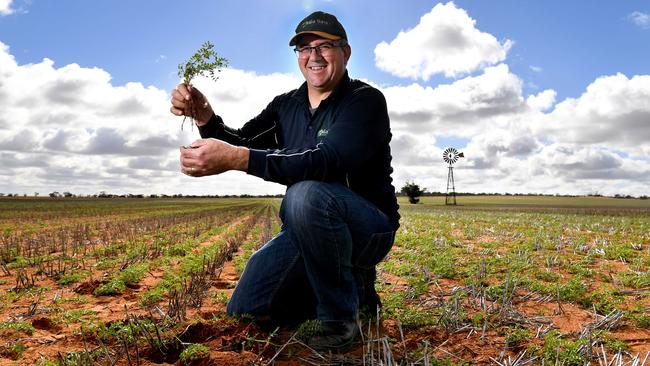
While the cropping season has had almost a picture-perfect start, talk of Chinese barley tariffs during the week meant a late change to what’s going in the ground.
“Unfortunately, 80 per cent of the barley we planned to put in was already in the ground when the China announcement came through, which is pretty frustrating.
“We took the opportunity to change two paddocks from barley to wheat because, luckily, we had the seed available,” he said.
The last years of high production in the Mallee were 2016 and 2010 – and he is hopeful of a repeat this year.
RAISING A GLASS TO RESILIENCE
For viticulturist Ashley Ratcliff, planting varieties suited to a changing Australian climate has paid off.
This past vintage has been one of the toughest on record for SA, with yields well down in many regions and sales affected by COVID-19.
But Mr Ratcliff’s business, Ricca Terra, which means “rich earth” in Italian, has coped well with the challenges.
He and wife Holly are based at Angaston, in the Barossa Valley, but own a vineyard in Barmera, in the Riverland, which is run with the help of the Thompson family, of Loveday.
“I bought the (Barmera) property 17 years ago, with a plan to plant varieties more suited to the Australian climate,” Mr Ratcliff said.
“I focused on more Mediterranean and southern Italian varieties, which use less water and have less of an environmental footprint.”
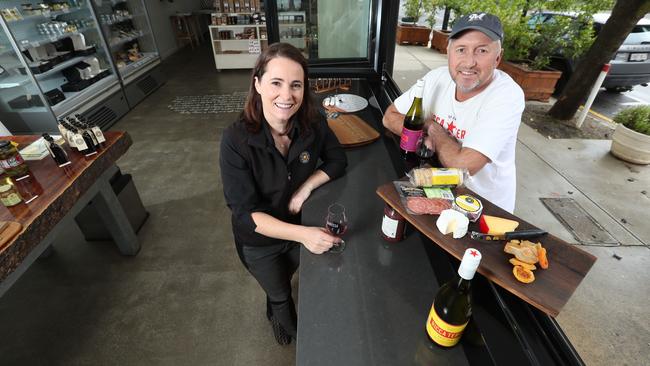
Rather than traditional varieties like chardonnay and cabernet sauvignon, Ricca Terra focuses on varieties such as Fiano and Montepulciano and Nero d’Avola – “a really robust, very vigorous red variety that doesn’t need much water on it”.
Mr Ratcliff said the Riverland had quite a good year for yields this past vintage.
Partnerships are also important, with his wine selling in friend Victoria McClurg’s Barossa Valley Cheese Company shop, at Angaston, and her cheese products available online through Mr Ratcliff’s website (riccaterravintners.com.au).
He said orders had kept coming in through the COVID-19 crisis, but he had noticed a change in consumer habits.
“People want their buck to go further, so it’s a great year for producers that sell in the sub-$25 a dollar market,” Mr Ratcliff said.
TOMATO GROWERS KEEP TOILING
Murray Bridge-based tomato growers Oriana and Keith Webb have worked in the horticultural sector for decades, but have now taken their business in a different direction.
“My husband and I have been in the industry for well over 30 years, but in the last five years we’ve gone into hydroponics (a method of growing plants without soil, instead using mineral nutrient solutions in a water solvent),” Ms Webb said.
“We’ve also invested in more automation and hi-tech growing rather than running an older-style greenhouse.”
The couple are directors of the Aquasun Produce, with their daughter, Melissa, working alongside them as finance manager.
Aquasun’s production area spans 6500sqm, with production of about 150 tonnes of tomatoes a year.
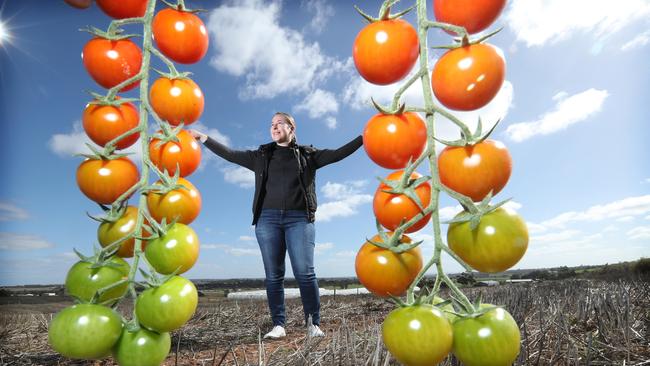
While the business had dabbled with capsicum and eggplant production in the past, the major focus is tomatoes.
“Tomato-growing is what we know how to do, and we do it well,” Ms Webb said.
“Tomato prices also seem to be steadier than other commodities.”
Even throughout the COVID-19 crisis, prices and demand for their produce has held up well.
“Our produce goes into the major produce markets (Adelaide, Brisbane, Sydney and Melbourne),” Ms Webb said.
“We also produce cherry tomatoes that go directly into Coles.”
At the peak of the season, in the summer months, the company can employ up to 20 people, with four full-time staff through the year.
Melissa said COVID-19 hadn’t had a major impact on the business.
“The focus for us is our staff and keeping them safe,” she said.
“This time of year, our staff numbers are down because of seasonal factors, so it’s been fairly easy to implement social distancing.
“Also, not a lot has changed from a demand respect – demand has remained steady.”
TYRANNY OF DISTANCE OFFERS JOBS HOPE
Farmer Garry Hansen believes there’s never been a better time for those in the livestock sector.
He is part of the Hansen Farms enterprise at Coomandook, which has a mix of sheep and cattle production, alongside cropping.
“Agriculture is a shining light and probably the best industry to be in at the moment,” he said.
Mr Hansen recently sold sheep through the online platform AuctionsPlus for some amazing money – hitting a top of $376 for his ewe hoggets and $271 for five-year-old ewes.
He said these prices were a good $80-$100 a head more than what he was expecting.
“They’re definitely some of the strongest sheep prices I’ve ever seen,” he said.
“The high prices being paid are mostly on the back of low sheep numbers and high meat prices.
“There’s a lot of optimism (in the livestock sector) at the moment.
“While the wool market hasn’t come back, most people are thinking that it will rebound.”
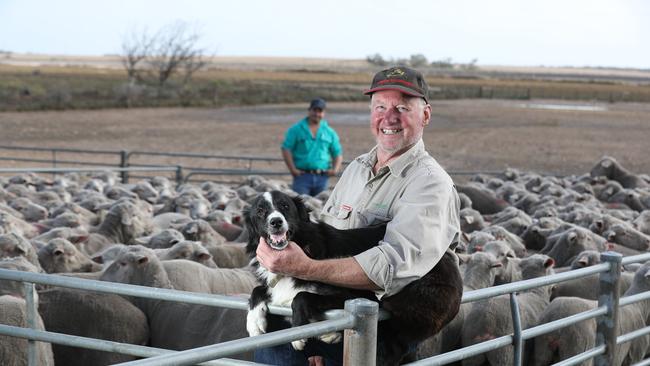
Mr Hansen believes sheep prices will stay strong for the foreseeable future, especially as the east coast recovers from extreme drought and farmers go on the hunt for extra livestock numbers.
“Having that extra demand is putting a base in the market for sheep,” he said.
Also helping farmer optimism is the good rainfall received in the past few months.
“I think it’s fair to say it’s been a one in 10 year start to the season,” Mr Hansen said.
“We’ve had a very good start at Coomandook, but from what I’ve heard it’s been a good start right across South Australia for the first time in many years.”
While city workers are being forced to jam like sardines into busy public transport, despite warnings around the importance of social distancing, Mr Hansen said the agriculture sector had found it relatively simple to adapt to COVID-19 guidelines.
“We employ five people and can deal with social distancing easily,” he said.
“With agriculture deemed an essential industry, and broadacre agriculture naturally equipped to deal with social distancing, I think, if anything, this situation will help increase our opportunities for attracting workers.”
